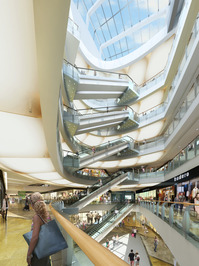The WPJ
THE WORLD PROPERTY JOURNALReal Estate Facts Not Fiction
Commercial Real Estate News

Report: No Oversupply of Shopping Malls in China
Commercial News » Asia Pacific Commercial News Edition | By WPJ Staff | April 9, 2013 9:03 AM ET
News reports showing vast empty shopping malls in China don't tell the whole story, according to a new report.
China's "consumer class" cities are growing at such at rapid rate, the new supply of shopping malls will be "readily absorbed" in the years ahead, according to Jones Lang LaSalle. In cities such as Shenyang, Wuhan, Chongqing, and Zhengzhou, the consumer class will actually grow faster than the supply of shopping malls between 2012 and 2015.
"Three years from now, the stock per metropolitan consumer will actually be lower in many cities than it is today," Jones Lang LaSalle concludes.
 JLL defines the consumer class as a person making RMB30,000 a year (about $4,800 a year). The percentage of the urban population that falls into this consumer class "varies widely between different cities in China," JLL reports.
JLL defines the consumer class as a person making RMB30,000 a year (about $4,800 a year). The percentage of the urban population that falls into this consumer class "varies widely between different cities in China," JLL reports.Of the 20 cities tracked by JLL, shopping mall vacancy is highest in Shenyang, Zhengzhou, and Chengdu.
"This mainly reflects the large percentage of the city's stock that was recently completed and has had little time to stabilize, rather than weakness in the overall market," the report states. "Over time, as these malls stabilize, the firm expects the vacancy rate to trend downward."
Ultimately, demographics won't be the key issue for retailers, JLL concludes. Malls in major cities will be successful if they can execute.
"Every city will have a handful of successful shopping malls regardless of the total level of stock in the city, but it will come down to good retail asset management to determine which schemes will succeed," said Steven McCord, local director for Jones Lang LaSalle Research Shanghai.
Sign Up Free | The WPJ Weekly Newsletter
Relevant real estate news.
Actionable market intelligence.
Right to your inbox every week.
Real Estate Listings Showcase
Related News Stories
Commercial Real Estate Headlines
- U.S. Commercial Mortgage Delinquencies Rise in Q2, CMBS Loans Lead the Surge
- Tokenization-Focused Real Estate Investment Bank Announced
- Commercial Cap Rates Edge Lower in U.S., Hinting at Market Turn
- WPV Targets New $6 Trillion Digital Real Estate Tokenization Opportunity
- $1 Trillion in Data Center Development Underway Through 2030
- WORLD PROPERTY VENTURES: The 'Anti-VC' of Real Estate Plans Major Capital Raise
- Multifamily Sector Enjoys Record Absorption in U.S. as Supply Slows, Vacancies Drop
- Employee Back-to-Office Attendance Surges in U.S.
- Phnom Penh Commercial Property Sectors Face Crosswinds in 2025
- World Property Bank Announced to Capitalize on Coming Trillion-Dollar Tokenization Boom
- REAL ESTATE PREDICTIONS: Decentralized Events Contract Exchange in Development
- U.S. Architecture Billings Improve Slightly in May
- Tokyo Office Demand Spills into Non-Core Wards in 2025
- AI Hyperscalers Drive Record Data Center Leasing in Early 2025
- Commercial, Multifamily Mortgage Debt in U.S. Hits Record $4.81 Trillion in Early 2025
- U.S. Multifamily Market Rebounds in Early 2025
- U.S. Office Market Experiences Historic Conversion Shift
- New York City Enters New Era of Office-to-Residential Conversions
- World Property Ventures Plans New Capital Raise
- U.S. Commercial Real Estate Lending Rebounds Sharply in Early 2025
- U.S. Multifamily Housing Confidence Declines in Early 2025
- Asia Pacific Commercial Investment Holds Steady in Early 2025
- Carnival Plans New Miami Headquarters Spanning Over 600,000 Square Feet
- Hong Kong Property Investors Take a Wait-and-See Approach Due to U.S. Tariffs
- U.S. Multifamily Buyer and Seller Sentiment Improves in Early 2025
- One Trillion Dollars of America's Commercial Property Loans Mature in 2025
- U.S. West Coast Dominates Self Storage Demand
- Phoenix, Orange County and Inland Empire Emerge as Leading U.S. Industrial Markets
- U.S. Mega Distribution Centers Leasing Activity Grew in 2024
- U.S. Commercial Borrowing to Increase to $583 Billion in 2025, Up 16 Percent Annually
- Demand for U.S. Life Sciences Space Spikes 28 Percent Annually in Late 2024
- Multifamily Property Sector in America Rebounding
- Asia Pacific Commercial Property Investment Spikes 23 Percent in 2024
- U.S. Commercial Property Market Primed for Growth in 2025
- Architecture Industry Sees Mixed Signals as 2025 Approaches
- Global Data Center Demand Spikes in 2025
- 2025 Prediction: U.S. Commercial Investment Recovery Expected to Gain Traction
- Holiday Retail Sales for 2024 to Hit Record $1 Trillion
- Tech, AI Industries Drive Largest Share of Office Leasing Activity in U.S.
- Commercial Real Estate Lending in U.S. Enjoys Strong Growth in Q3
Reader Poll
Marketplace Links
This website uses cookies to improve user experience. By using our website you consent in accordance with our Cookie Policy. Read More







